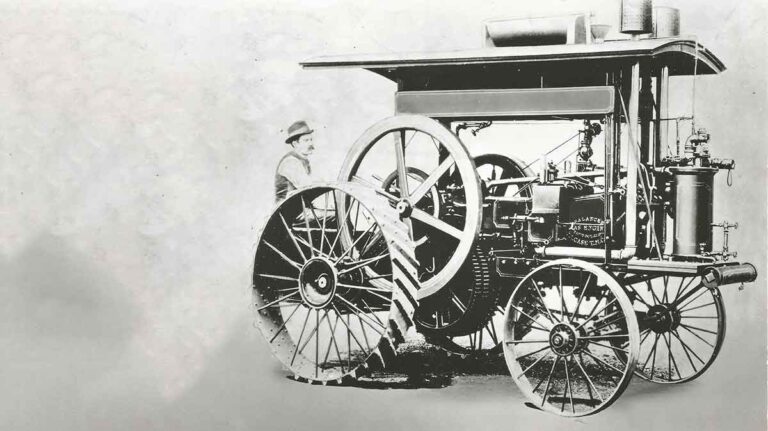The company, established by Jerome Increase Case, made a huge contribution to the development of power farming. His ancestor, John Case, had emigrated to America from England in 1633, and the family farmed in New York state where Jerome was born in about 1819.
Their farming activities included a contract threshing business run by Jerome, and this encouraged his interest in machinery development.
See also: Whatever happened to…John Deere Model A?
The interest in a threshing machine he designed encouraged him to give up the contracting business and start a new career as a farm machinery manufacturer based in Racine, Wisconsin.
Case threshers and other machines were available from 1844 and their success allowed the company to expand rapidly, with further growth when agricultural steam engines were added to the product range.
The first Case steamers were portable engines arriving around 1869, pulled by horses and used for powering stationary equipment such as threshing machines.
Self-propelled traction engines were added in 1878, and by the early 1900s Case was established as the world’s biggest manufacturer of agricultural steam engines, continuing until 1926 when demand for steam equipment was ending.

The next development in tractor history came in 1889, followed in 1892 when three more tractors were completed in America in the same year, including one from the Case company.
Case death
Jerome Case may have instructed his engineers to start the tractor programme, but he died following a period of poor health just a few months before the tractor was completed.
Work on the project had started several years previously, but progress had been slow because of engine problems, and another factor causing delay may have been the increasing success of the company’s steam engines and other products, which meant keeping pace with demand was a major priority.
Petrol engines were still at an early stage of development in the early 1890s when the first Case tractor was designed and built, and most of the engines were based on a single cylinder and suffered from poor reliability and low efficiency.
An example was the Van Duzen engine powering the Froelich, another of the three prototype or experimental tractors built in 1892. The capacity of the Van Duzen single cylinder was a massive 35.3 litres, but the rated output was a decidedly modest 16hp or less than 0.5hp per litre, and the big cylinder could not provide smooth operation.
Two cylinders
Engineers developing the first Case tractor tried to achieve a smoother performance by choosing an engine with two cylinders that were horizontally opposed to reduce the thrust forces.
This was a recently introduced design by William Paterson from Scotland. It produced about 30hp on the belt pulley, and to emphasise its smooth operation it was called a ‘Balanced’ engine, but in spite of this the lack of reliability was unacceptable.
Apart from the engine problems, the rest of the tractor was based mainly on a modified version of a Case traction engine, and this gave a satisfactory performance.
Meanwhile, the company’s steam engine sales were increasing, with annual production of portable and traction engines peaking in 1912 at 2,252.
Production tractors were added to the Case range in 1911 when the 30-60 model arrived with 60hp available at the flywheel.
It was joined in 1912 by a smaller version with a 40hp engine, and by luck or good judgement this provided Case with a two-model range just in time to benefit from the huge expansion in tractor sales during the 1914-18 war.
Commercial success
Commercial tractor production was the start of a new era for the Case company, which emerged as one of the tractor industry’s most successful manufacturers.
In fact, the Case response to the arrival of tractor power is a textbook example of how companies can handle the arrival of a new and potentially competing product.
Many established manufacturers of agricultural steam engines in the United States and Britain did little to prepare for the arrival of farm tractors, including some that simply continued building their traditional steam engines for a market that would soon disappear.
Having experimented with one of the world’s first tractors, Case kept up to date with technical developments to ensure they were ready to move into the tractor market at the optimum time.


